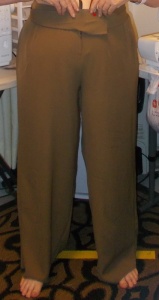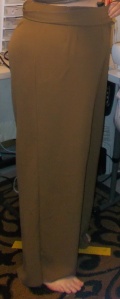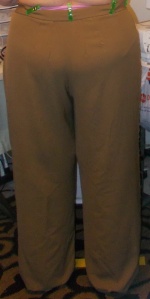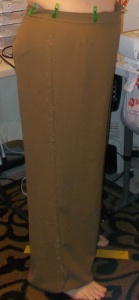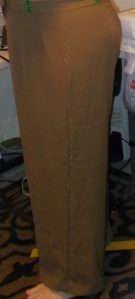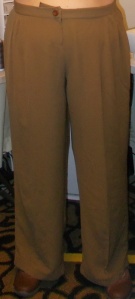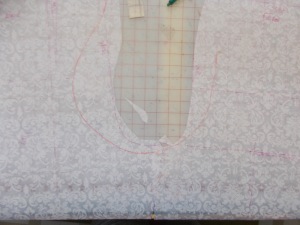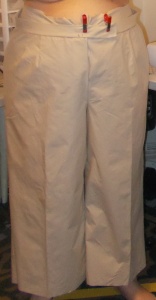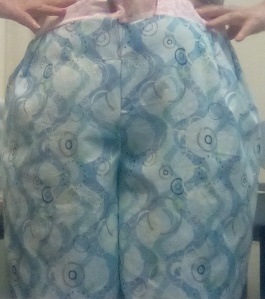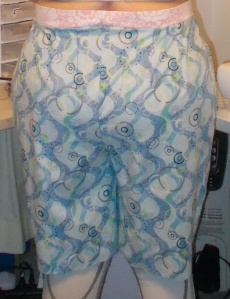I transferred the waistband location added SA and marked the darts, but I did not transfer any of the other changes made to the muslin. For fitting insurance, I marked 1/2″ above the marked seam allowance. I can always trim. Adding after-the-fact is difficult if not impossible. Plus that gives extra to shape for the dart tops.
Then I begin the job of choosing a fabric. The muslin looked so good I wanted to use a reasonable good fabric in this (I hoped) first pair of pants. Because my alterations have increased the hem circumference to 24″, I wanted a fabric that draped close to the body but not reveal all. Normally my pant colors are black, dark navy blue and dark chocolate brown. All colors that are difficult to photograph and will be difficult for me to see drag lines. My chosen fabric is a caramel brown. It is Polyester with a little Lycra which Fabricmartfabric advertised a Fine Twill. I love this stuff. Buy it everytime I see it on their website. Has 10% crosswise stretch–no vertical stretch. It is light weight as in ounces per square yards but feels heavy in-hand and drapes like crepe. The weight I have is not a winter fabric unless I wear thick tights or long johns. It works fine for fall, spring and some summer occasions.
I cut my fabric and serge finished all the edges. I put the zipper in then swapped out to water-soluble thread in the bobbin before basting everything together.
As with the muslin, fitting was all about correctly placing the waistband aka crotch depth. I was shocked that my crotch depth was 2″ too long. Here’s my first fitting.
Fit01
I embarked on a series of fitting adjustments all tweaking the crotch depth and adapting the waist to the WB. Eventually I settle on decreasing the front crotch and sides 2″ but the back 3″. I also offset the back side seam to add another 1/2″ ease across the seat (and there is still a hint of VPL). I want you to see the final fitting before the finished garment:
Last fitting:
Pretty nice, if I do say so myself. From there I opened seams where they crossed just enough to get and make permanent stitches. I trimmed the excess at the top and the point which formed where the inseams and crotch met. Hemmed and applied the waistband. Nothing was entirely ripped. Buttonhole and button were carefully placed to they would occupy the same place at the clips. The finished pant fits slightly different from the final fitting.
Finished:
I immediately noticed that the waistband was not as firmly in place as before and I could feel the pant drop slightly. It also appears that I have lost 5 pounds in the 24 hours between last fitting and final pictures. I really should start automatically inserting elastic before I nail the waistband in place. Just for info purposes, last fitting was done about 2 o’clock the day before. Final pics about 2 o’clock the next day. TMI but no I have not been starving myself, peeing a lot or had diarrhea. Well moving along… the real problem with this pair of pants is: once I have a good fitting pair of pants, I can’t stand to wear the others. I will have to be making more and making them soon.
I did not transfer my depth changes to the pattern. I am unsure why the torso (from waist to crotch) grew 2″ in front, 1″ on the sides, and 3″ in back. Honestly, I didn’t know whether the fiber (poly lycra), the weave (fine twill) or 10% width-wise stretch which made the huge difference. Normally a 10% stretch fabric behaves much the same and is treated as a stable weave/knit. I know there can be some difference even if the fiber and weave are the same. I expect more difference when the stretch factor gets to 25% and am pretty sure that a 50% or greater stretch will almost require an entirely different pattern.
I’ve made a trouser. I didn’t start out to create a trouser. I would prefer to wear a pant with lesser ease. Not sure that will be possible for me. First my round, prominent rear will always need additional fabric. Covering the seat will probably add fabric across the thigh. As I explained in the previous post, I just don’t know how to draw a curve adding 3″ to the side while dovetailing into the thigh side seam without adding more ease in the thigh as well. Because of how I did my tissue alteration for the seat, I added 3″ to the hem. That created a 24″ hem circumference. Even with this nicely draping polyester fabric, I don’t like the 24″ finished hem circumference. I am narrow shouldered and short. A big wide leg, makes me look shorter and my shoulders narrower. In future makes, I will attempt to make the legs narrower, about 20″. However, for the next pair, I want to test crotch depth changes by sewing the same (i.e.no other tissue changes) with a similar fabric.

